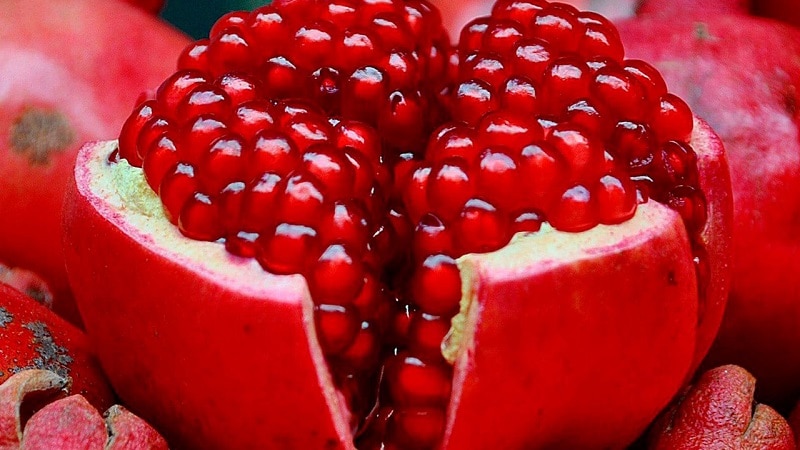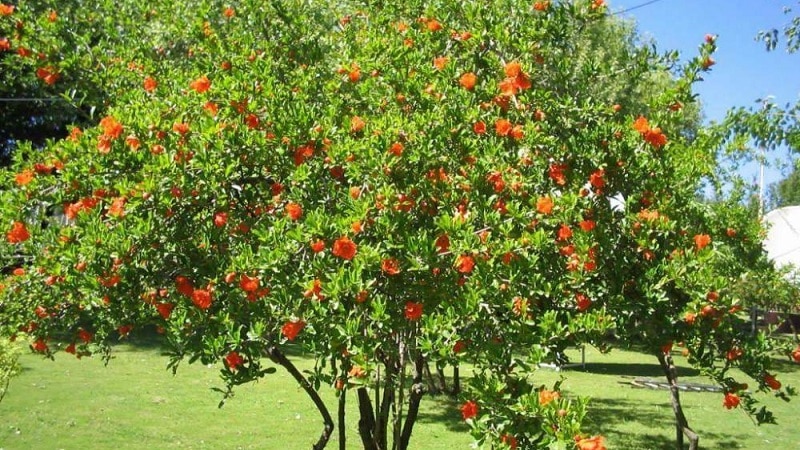What is a pomegranate - a berry or a fruit?
Today you won’t surprise anyone with a pomegranate. Its fruits are sold in markets and stores. However, not everyone knows whether pomegranate is a berry or a fruit. In a plant many useful and medicinal properties, it is used in cosmetology and cooking. Trees are grown both as indoor crops and as hedges in gardens and parks.
What is pomegranate
The name "pomegranate" is of Latin origin and means "grainy." The generic name Punica comes from the Latin. punicus - “Punic, Carthaginian.”

To find an accurate definition for fruits, you need to know the criteria for their classification. In fruits it is juiciness and sweetness. However, in botany there is no term “fruit” - there is only “fruit”. Therefore, pomegranate is recognized as a variety of succulent berry-like plants. In everyday life it is considered a fruit and is looked for among them at the market or in a store.
Reference. The correct name for the pomegranate fruit is pomegranate.
The fruits of the plant contain many useful substances. Core Value — vitamins: group B, as well as C, P, E, K. The juice contains malic, citric, oxalic, succinic and tartaric organic acids. Pomegranate is especially rich in tannins (up to 33% in the bark and pericarp).
Minerals in the fruit:
- sodium;
- magnesium;
- phosphorus;
- potassium;
- silicon;
- calcium;
- iodine;
- iron;
- manganese.
Pomegranate saves from vitamin deficiency, prevents the development of oncology and various inflammations, and is used for the prevention and auxiliary treatment of diseases of the genitourinary system. The peel has bactericidal properties.
Botanical description of the plant Pomegranate
The plant lives in a subtropical climate. It is grown in Crimea, the Caucasus and Uzbekistan, and abroad - in Italy, Turkey, Greece, and China. Persia is considered the birthplace of the pomegranate.
Which family does it belong to?
In Ancient Rome, pomegranate was called a Punic or granular apple, in the Middle Ages - a seed apple. Later, the plant was assigned to the monotypic family Garnetaceae, but since 2003 it has been included in the Derbennikovaceae family. About 70% of trees, shrubs and grasses of this family grow in tropical and subtropical climates.
 Pomegranate represents a small tree or shrub, usually evergreen or deciduous. The yield reaches 50–60 kg per plant. The crop lives for about 50 years, but in old trees the yield is significantly reduced.
Pomegranate represents a small tree or shrub, usually evergreen or deciduous. The yield reaches 50–60 kg per plant. The crop lives for about 50 years, but in old trees the yield is significantly reduced.
These are cross-pollinated plants, their regular guests are bees, beetles and butterflies. Sometimes self-pollination occurs.
Flowering is very abundant and long lasting - from May to August. The fruits form and ripen within 130–160 days. When fully ripe, their color does not change.
What does a pomegranate tree look like?
The pomegranate tree reaches a height of 5-6 m. It is small and may look like a spreading shrub, depending on the variety. The branches are thin and thorny. Bright red-orange flowers reach 3 cm in diameter and are shaped like bells.
The color of the fruit can vary from orange-yellow to brown-red. The weight of mature pomegranates reaches 0.5 kg, diameter - 12 cm.
Reference. In ancient Egypt, pomegranates were called Carthaginian apples. During the reign of the pharaohs, gardens made from these plants were very popular.
The tree itself looks decorative: a low trunk turns into a lush crown dotted with flowers or fruits.Pomegranates can crack directly on the branches, but their grains do not crumble, which looks very exotic.
Lush foliage starts almost from the ground. Flowers and the fruits are located throughout the bush. The leaves are light green, oval in shape, and the length does not exceed 3-4 cm. The foliage densely covers each branch.

Pomegranate fruit
The structure of grenade looks very interesting in cross-section. The peel of the fruit is dry and dense, 2-3 mm thick. Beneath it are red juicy seeds, their number can reach 600–700 pieces. The seeds are divided into segments by thin membrane films.
The taste of the seeds is sweet and sour. The peel and membranes are bitter.
Reference. Pomegranate peel used as an astringent, wound-healing, choleretic agent, and for sore throat.
Many residents of the northern regions grow crops at home. Dwarf varieties and specially bred domestic varieties are suitable for this.
- Ruby;
- Nana;
- Baby;
- Bala-mursal;
- Carthage is dwarf.

Indoor varieties:
- Wonderful;
- Purple;
- Güleisha;
- Kzyl-Anar;
- Shah-Nar.
Conclusion
Pomegranate is one of the champion plants in beauty, taste and benefits. You can grow it not only in the garden, but also at home, by planting specially bred dwarf and indoor varieties. Although the fruit is called a fruit, from a botanical point of view it is a berry (pomegranate).